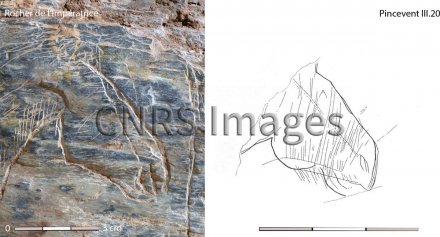Production year
2016

© Nicolas NAUDINOT/ Camille BOURDIER / CEPAM / TRACES / PLOS ONE / CNRS Images
20170070_0008
Engraved horse heads from the Rocher de l’Impératrice and Pincevent sites. Begun in 2013, the digs at the Rocher de l’Impératrice site in Plougastel-Daoulas, Finistère, led to the discovery, inside a dwelling, of engraved schist tablets dating from the early Azilian, 14,500 years ago. These tablets, the oldest evidence of artwork in Brittany, show a geometric register (hatching, grids and zigzags) as well as naturalistic representations of horses, as in this case, and aurochs. Traces of charcoal identified on several of them suggest that these tablets were painted. The horse-head engraving uncovered during a more recent period of occupation of the Pincevent site (13,600 years ago) shows striking similarities to those found at the Rocher de l’Impératrice, testifying to the perpetuation of stylistic codes within these societies before the development of geometric art painted and engraved on small stones during a more recent period of the Azilian. (Naudinot N, Bourdier C, Laforge M, Paris C, Bellot-Gurlet L, Beyries S, et al. (2017) Divergence in the evolution of Paleolithic symbolic and technological systems: The shining bull and engraved tablets of Rocher de l'Impératrice. PLoS ONE 12(3): e0173037.)
The use of media visible on the CNRS Images Platform can be granted on request. Any reproduction or representation is forbidden without prior authorization from CNRS Images (except for resources under Creative Commons license).
No modification of an image may be made without the prior consent of CNRS Images.
No use of an image for advertising purposes or distribution to a third party may be made without the prior agreement of CNRS Images.
For more information, please consult our general conditions
2016
Our work is guided by the way scientists question the world around them and we translate their research into images to help people to understand the world better and to awaken their curiosity and wonderment.